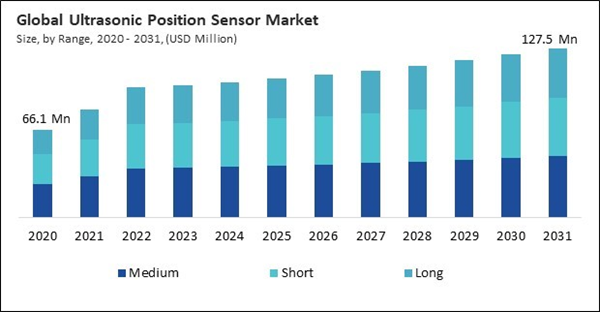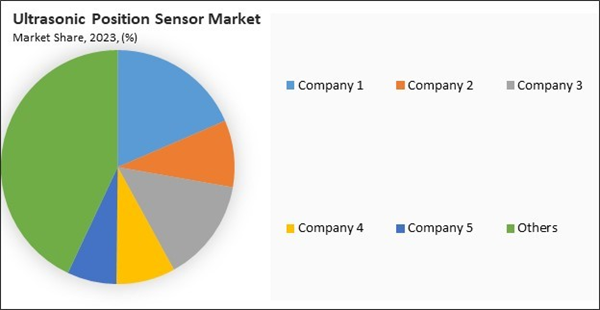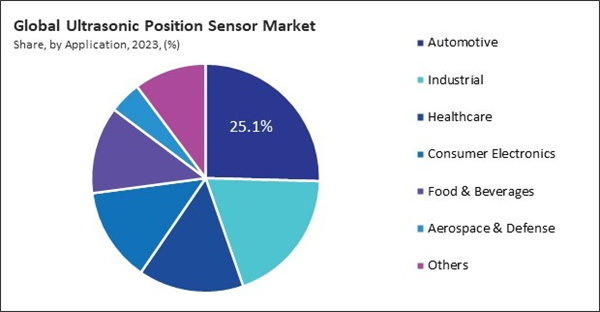The automotive industry's extensive implementation of ultrasonic sensors for advanced driver-assistance systems (ADAS), parking assistance, blind-spot detection, and collision avoidance functions is responsible for this accomplishment. Therefore, the automotive segment procured$25.32 million revenue in the market in 2023. The increasing demand for vehicle safety and automation technologies, coupled with regulatory mandates for enhanced safety standards in vehicles, drove substantial growth and revenue generation in the automotive segment of the market.
The demand for ultrasonic position sensors in the automotive industry is on the rise, predominantly due to their critical function in advanced driver-assistance systems (ADAS). These systems, designed to enhance vehicle safety and driver convenience, rely heavily on ultrasonic sensors' precise detection and measurement capabilities. With a growing emphasis on vehicle safety and regulatory requirements, the adoption of collision avoidance systems powered by ultrasonic sensors is expected to continue rising. Hence, all rising demand in the automotive industry will aid in the market's growth.
Moreover, amidst a multitude of processes, the industrial sector is currently experiencing a profound revolution characterized by the exponential acceleration of automation implementation. In industrial automation systems, ultrasonic position sensors are essential for monitoring and controlling various parameters. They enable precise positioning of actuators, valves, and other mechanical components in automated machinery and production lines. This level of precision is crucial for maintaining quality standards, minimizing errors, and maximizing productivity in industrial settings. Thus, all these factors will aid in the market's growth.
However, ultrasonic sensors, renowned for their reliability and precision in short to medium-range distance measurements, encounter challenges when tasked with longer-range applications. This limitation primarily stems from the physics of sound wave propagation, where the intensity and fidelity of ultrasonic signals tend to diminish as distances increase. As a result, the performance of ultrasonic sensors can become less accurate and less reliable in scenarios demanding precise measurements over extended distances, such as long-range object detection or large-scale industrial environments. This limitation can hinder their adoption and thus hamper the growth of the market.
The leading players in the market are competing with diverse innovative offerings to remain competitive in the market. The above illustration shows the percentage of revenue shared by some of the leading companies in the market. The leading players of the market are adopting various strategies in order to cater demand coming from the different industries. The key developmental strategies in the market are Acquisitions, and Partnerships & Collaborations.
Driving and Restraining Factors
Drivers- Increasing Demand in The Automotive Industry
- Rising Industrial Automation
- Ongoing Advancements in Sensor Technology
- Limited Range and Accuracy
- High Initial Cost of Ultrasonic Sensors
- Expanding Trend of Miniaturization
- Expansion Of IoT and Smart Devices
- Complexity Of Integration into Existing Systems
- Competition From Other Sensor Technologies
Range Outlook
Based on range, the market is characterized by short, medium, and long. The short segment procured 34% revenue share in the market in 2023. The prevalence of this segment in practical applications that necessitate accurate distance measurements in close proximity is the reason for its dominance. Industries such as automotive (for parking assistance and obstacle detection), industrial automation (for proximity sensing and object detection), and consumer electronics (for gesture recognition and touchless interfaces) contributed significantly to the demand for short-range ultrasonic sensors, driving its revenue share to the top position.Application Outlook
On the basis of application, the market is classified into automotive, industrial, consumer electronics, healthcare, food & beverages, aerospace & defense, and others. The industrial segment recorded 19% revenue share in the market in 2023. Manufacturing, logistics, material handling, and industrial automation rely on ultrasonic sensors for proximity sensing, object detection, level measurement, and automated positioning applications.Regional Outlook
Region-wise, the market is analyzed across North America, Europe, Asia Pacific, and LAMEA. The Europe segment garnered 36% revenue share in the market in 2023. The automotive, aerospace, healthcare, and industrial automation sectors, which are all substantial consumers of ultrasonic sensors, are among the key industries that contribute significantly to the success of the segment.List of Key Companies Profiled
- Rockwell Automation, Inc.
- Omron Corporation
- Balluff GmbH
- Baumer Holding AG
- Honeywell International, Inc.
- Murata Manufacturing Co., Ltd.
- Banner Engineering Corporation
- Hans Turck GmbH & Co. KG
- Pepperl + Fuchs Group
- Sick AG
Market Report Segmentation
By Range- Medium
- Short
- Long
- Automotive
- Industrial
- Healthcare
- Consumer Electronics
- Food & Beverages
- Aerospace & Defense
- Others
- North America
- US
- Canada
- Mexico
- Rest of North America
- Europe
- Germany
- UK
- France
- Russia
- Spain
- Italy
- Rest of Europe
- Asia Pacific
- China
- Japan
- India
- South Korea
- Singapore
- Malaysia
- Rest of Asia Pacific
- LAMEA
- Brazil
- Argentina
- UAE
- Saudi Arabia
- South Africa
- Nigeria
- Rest of LAMEA
Table of Contents
Companies Mentioned
- Rockwell Automation, Inc.
- Omron Corporation
- Balluff GmbH
- Baumer Holding AG
- Honeywell International, Inc.
- Murata Manufacturing Co., Ltd.
- Banner Engineering Corporation
- Hans Turck GmbH & Co. KG
- Pepperl + Fuchs Group
- Sick AG
Methodology

LOADING...











